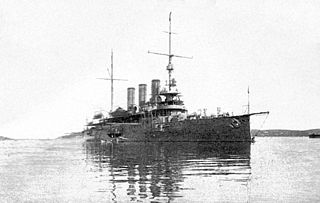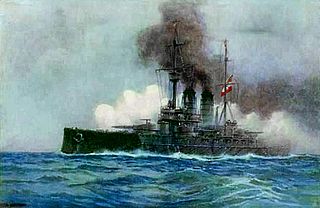
SMS Zrínyi was a Radetzky-class semi-dreadnought battleship (Schlachtschiff) of the Austro-Hungarian Navy, named for the Zrinski, a Croatian-Hungarian noble family. Zrínyi and her sisters, Erzherzog Franz Ferdinand and Radetzky, were the last pre-dreadnoughts built for the Austro-Hungarian Navy.

The Tegetthoff class was a class of four dreadnought battleships built for the Austro-Hungarian Navy. Named for Austrian Admiral Wilhelm von Tegetthoff, the class was composed of SMS Viribus Unitis, SMS Tegetthoff, SMS Prinz Eugen, and SMS Szent István. Construction started on the ships shortly before World War I; Viribus Unitis and Tegetthoff were both laid down in 1910, Prinz Eugen and Szent István followed in 1912. Three of the four warships were built in the Stabilimento Tecnico Triestino shipyard in Trieste; Szent István was built in the Ganz-Danubius shipyard in Fiume, so that both parts of the Dual Monarchy would participate in the construction of the ships. The Tegetthoff-class ships hold the distinction for being the first and only dreadnought battleships of the Austro-Hungarian Navy. The SMS Szent István had a different more modern propulsion system than her sister ships.

SMS Szent István was the last of four Tegetthoff-class dreadnought battleships built for the Austro-Hungarian Navy. Szent István was the only ship of her class to be built within the Hungarian part of the Austro-Hungarian Empire, a concession made to the Hungarian government in return for its support for the 1910 and 1911 naval budgets which funded the Tegetthoff class. She was built at the Ganz-Danubius shipyard in Fiume, where she was laid down in January 1912. She was launched two years later in 1914, but Szent István's construction was delayed due to the smaller shipyards in Fiume, and further delayed by the outbreak of World War I in July 1914. She was finally commissioned into the Austro-Hungarian Navy in December 1915.

SMS Prinz Eugen was the third of four Tegetthoff-class dreadnought battleships built for the Austro-Hungarian Navy. Prinz Eugen was named for Prince Eugene of Savoy, a Habsburg general and statesman during the 17th and 18th centuries most notable for defeating the Ottoman Empire at the Battle of Zenta in 1697. The ship was armed with a main battery of twelve 30.5 cm (12.0 in) guns in four triple turrets. Constructed shortly before World War I, she was built at the Stabilimento Tecnico Triestino shipyard in Trieste, where she was laid down in January 1912 and launched in November that same year.

SMS Sankt Georg was the third and final armored cruiser of the Austro-Hungarian Navy. She was built at the Pola Arsenal; her keel was laid in March 1901, she was launched in December 1903, and completed in July 1905. Her design was based on the previous armored cruiser Kaiser Karl VI, with the primary improvement being a stronger armament. Sankt Georg, named for Saint George, was armed with a main battery of two 24-centimeter (9.4 in) guns, five 19 cm (7.5 in) guns, and four 15 cm (5.9 in) guns.

The Erzherzog Karl class was a class of pre-dreadnought battleships of the Austro-Hungarian Navy built before World War I. All of the battleships of the Erzherzog Karl-class were built in the Stabilimento Tecnico Triestino shipyards in Trieste. The first battleship, Erzherzog Karl was laid down in 1902. Construction on the remaining two battleships, Erzherzog Ferdinand Max and Erzherzog Friedrich continued up to 1905. Erzherzog Karl was commissioned in 1906, while Erzherzog Ferdinand Max and Erzherzog Friedrich were commissioned in 1907. The three Erzherzog Karl-class battleships were considered relatively modern by the time they were commissioned. However, small docking space and budget restraints resulted in the class being fairly compact. Nevertheless, they were well designed and properly protected. The Erzherzog Karl class were the last and largest pre-dreadnoughts built by the Austrian Navy. They were named after members of the Austrian Royal family.

The Habsburg class was a group of pre-dreadnought battleships built by Austria-Hungary at the turn of the 20th century. They were the first sea-going battleship built by Austria-Hungary since the central battery ship Tegetthoff in 1876. The class was composed of three ships: Habsburg, Árpád, and Babenberg. They were armed with three 24 cm (9.4 in) guns in two turrets and were capable of slightly better than 19.5 knots at full speed. Habsburg and Árpád were modernized in 1910–11.

SMS Radetzky was the first of the three Radetzky-class pre-dreadnought battleships built for the Austro-Hungarian Navy. She was named for the 19th-century Austrian field marshal Joseph Radetzky von Radetz. Radetzky and her sisters, Erzherzog Franz Ferdinand and Zrínyi, were the last pre-dreadnoughts built by the Austro-Hungarian Navy—they were followed by the larger and significantly more powerful Tegetthoff-class dreadnoughts.

SMS Erzherzog Karl was a pre-dreadnought battleship built by the Austro-Hungarian navy in 1902. The lead ship of the Erzherzog Karl class, she was launched on 3 October 1903. They were assigned to the III Battleship Division.

SMS Erzherzog Franz Ferdinand was an Austro-Hungarian Radetzky-class pre-dreadnought battleship commissioned into the Austro-Hungarian Navy on 5 June 1910. She was named after Archduke Franz Ferdinand. The first ship of her class to be built, she preceded Radetzky by more than six months. Her armament included four 30.5 cm (12 in) guns in two twin turrets, and eight 24 cm (9.4 in) guns in four twin turrets.

The Ersatz Monarch class was a class of four dreadnought battleships which were intended to be built between 1914 and 1919 for the Austro-Hungarian Navy. Design work on a class of battleships to succeed the Tegetthoff class and replace the aging Monarch class began in 1911. After going through several different design proposals, Anton Haus, Commander-in-Chief of the Austro-Hungarian Navy, secured passage of a naval expansion program through the Austro-Hungarian government to fund the construction of the battleships in April 1914.

SMS Erzherzog Ferdinand Max was a pre-dreadnought battleship built by the Austro-Hungarian Navy in 1902. The second ship of the Erzherzog Karl class, she was launched on 21 May 1905. She was assigned to the III Battleship Division.

SMS Erzherzog Friedrich was a pre-dreadnought battleship built by the Austro-Hungarian Navy in 1902. The second ship of the Erzherzog Karl class, she was launched on 30 April 1904. She was assigned to the III Battleship Division.

SMS Kaiser Karl VI was the second of three armored cruisers built by the Austro-Hungarian Navy. She was built by the Stabilimento Tecnico Triestino in Trieste between June 1896 and May 1900, when she was commissioned into the fleet. Kaiser Karl VI represented a significant improvement over the preceding design—Kaiserin und Königin Maria Theresia—being faster and more heavily armed and armored. She provided the basis for the third design, Sankt Georg, which featured further incremental improvements. Having no overseas colonies to patrol, Austria-Hungary built the ship solely to reinforce its battle fleet.

SMS Kronprinz Erzherzog Rudolf was a unique ironclad warship built for the Austro-Hungarian Navy in the 1880s, the fleet's last vessel of that type. The ship was laid down in January 1884, launched in July 1887, and completed in September 1889. She was armed with a main battery of three 30.5-centimeter (12 in) guns and had compound steel plating of the same thickness on her armored belt. The ship had an uneventful career, in large part due to her rapid obsolescence. She made trips to foreign countries to represent Austria-Hungary, but was reduced to a coastal defense ship by 1906. She continued in this role through World War I, based at Cattaro Bay, where her crew took part in the Cattaro Mutiny in early 1918. After the war, Kronprinz Erzherzog Rudolf was transferred to the Navy of the Kingdom of Serbs, Croats and Slovenes, renamed Kumbor and classed as a coastal defence ship, but she remained in their inventory for only a year, being sold for scrap in 1922.

The Škoda 30.5 cm /45 and Škoda 30.5 cm /45 K10 were a family of related naval guns of the Austro-Hungarian Empire that were used aboard the last classes of pre-dreadnoughts and dreadnoughts of the Austro-Hungarian Navy during the World War I. Guns salvaged from these ships after World War I were later used by the Royal Italian Army as coastal artillery during World War II.

SMS Tegetthoff was the second of four Tegetthoff-class dreadnought battleships built for the Austro-Hungarian Navy. Tegetthoff was named for the 19th-century Austrian Admiral Wilhelm von Tegetthoff, most notable for defeating the Italian Regia Marina at the Battle of Lissa in 1866. The ship was armed with a main battery of twelve 30.5 cm (12.0 in) guns in four triple turrets. Constructed shortly before World War I, she was built at the Stabilimento Tecnico Triestino shipyard in Trieste, where she was laid down in September 1910 and launched in March 1912.

SMS Kaiser Franz Joseph I was a protected cruiser built for the Austro-Hungarian Navy. Named for the Austrian emperor and Hungarian king Franz Joseph I, Kaiser Franz Joseph I was the lead ship of her namesake class. Constructed by Stabilimento Tecnico Triestino in Trieste, she was laid down in January 1888 and launched in May 1889. Kaiser Franz Joseph I was commissioned into the Navy in June 1890. As the first protected cruiser constructed by the Austro-Hungarian Navy, she was intended to serve as Austria-Hungary's response to the Italian cruisers Giovanni Bausan and Etna. Her design was heavily influenced by the Jeune École, a naval strategy which had gained prominence in the 1880s as a means to combat a larger and more heavily armored navy of battleships through the use of torpedo flotillas.

















